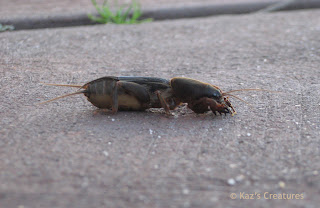Today my son found a mole cricket while digging over the compost heap. Wanting to show me, he carried it in his hand, only to discover they have very strong burrowing forelegs, and are not very good at distinguishing ‘hand’ from ‘sand’. Needless to say, he dropped it a few times before bringing it to me on a blue spade. Surprisingly these insect can fly despite looking so bulky, and spending much of their time burrowing underground.
As usual, we then followed up with some online research, leading to discovering newspaper articles from 1913 and 1927 and a lovely old book by entomologist Walter Wilson Froggatt (1858-1937).
Western Mail (Perth, WA) Thursday31 March 1927 p 7
MOLE CRICKET
"Scotty," Bridgetown, writes:-I am sending you an insect enclosed in a small bottle with methylated spirits hoping you will find space in your columns to tell me what it is. It digs into the ground making a small burrow wherein it emits a, very loud shrill whistling sort of noise. This one was dug up about a foot below the surface in a clear paddock by the house, but there are several in different places all over the paddock.
The insect proved to be a mole cricket regarding which two correspondents wrote on March 3 complaining of the damage done by these insects on tennis lawns by their raising little mounds of soil round their burrows. As it lives underground and usually comes out at night, it is not familiar to many people although fairly common. Regarding this insect Mr W Froggatt in his book on Australian insects says:-"The mole cricket (Gryllotalpa coarctata) is found all over the interior, forming under- ground tunnels in the sand along the edges of watercourses; it was collected in the Horn Expedition in Central Australia, and is also found about Sydney, It is of the usual dull brown tint with hooded thorax and spade-shaped forelegs.'' These little creatures are vegetable feeders and live on the roots of grass and other plants, It gets its name from the fact that it burrows like a mole and is provided with strong front claws for the purpose.
Australian insects. By Walter W. Froggatt., Sydney,W. Brooks[1907]


Further reading: Western Australian Museum fact sheet
Addendum: 15 September 2011:
I've had some wonderful feedback from Dr Terry Houston, Senior Curator (Entomology), Dept. of Terrestrial Zoology, Western Australian Museum, who was kind enough to read my article and he tells me "the Sunday Times article could confuse readers because Cylindracheta kochii is a sandgroper, not a mole cricket, and wouldn't push up mounds of soil. However, at the time the article was written, sandgropers and mole crickets were classified into one family. The mounds of soil referred to might have been produced by a mole cricket but could also have been the work of a native bee."
Addendum: 15 September 2011:
I've had some wonderful feedback from Dr Terry Houston, Senior Curator (Entomology), Dept. of Terrestrial Zoology, Western Australian Museum, who was kind enough to read my article and he tells me "the Sunday Times article could confuse readers because Cylindracheta kochii is a sandgroper, not a mole cricket, and wouldn't push up mounds of soil. However, at the time the article was written, sandgropers and mole crickets were classified into one family. The mounds of soil referred to might have been produced by a mole cricket but could also have been the work of a native bee."





Cool! I have often seen these around and just thought that they were weird looking crickets. Now I know. I have a 16 month old grandson so we spend alot of time crouched down low over the path or garden looking at wriggley things. Nice pics.
ReplyDeleteThank you for your comment. Positive feedback is always appreciated.
ReplyDelete